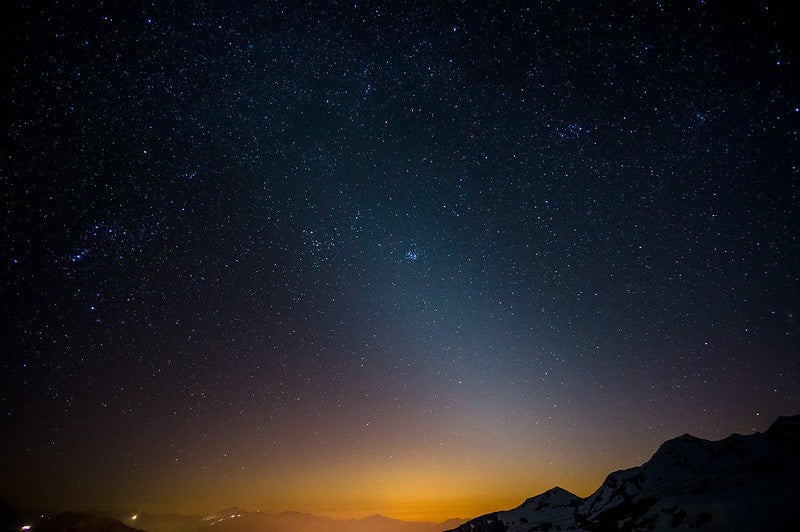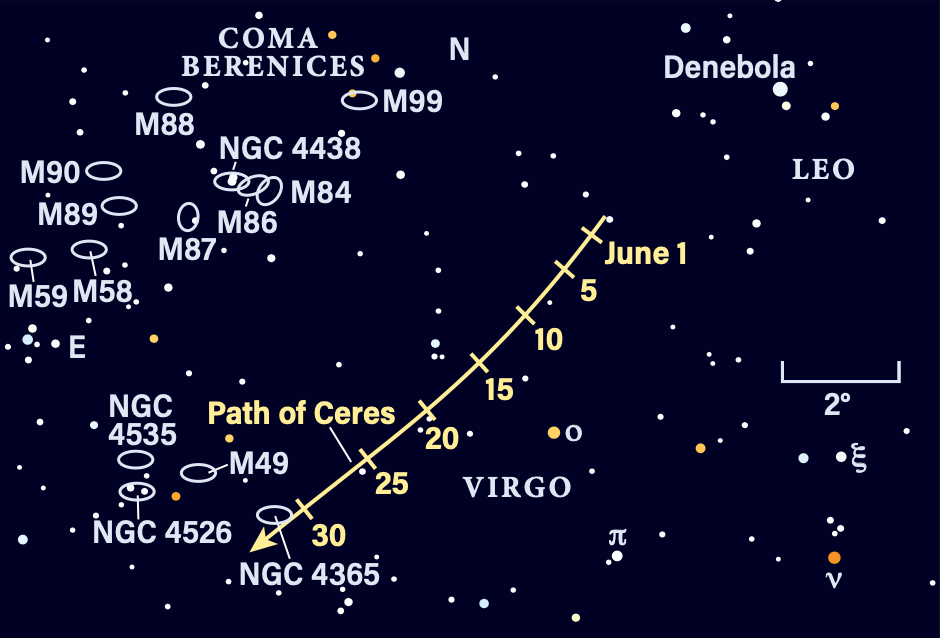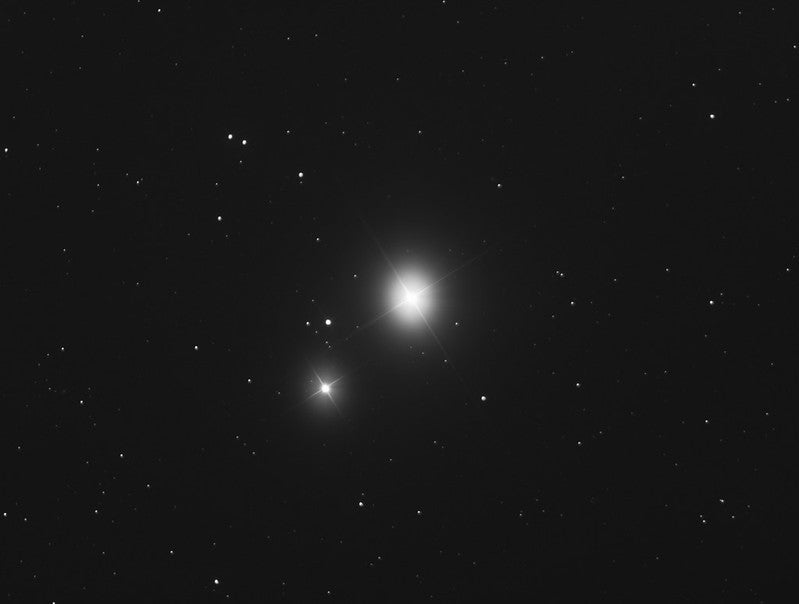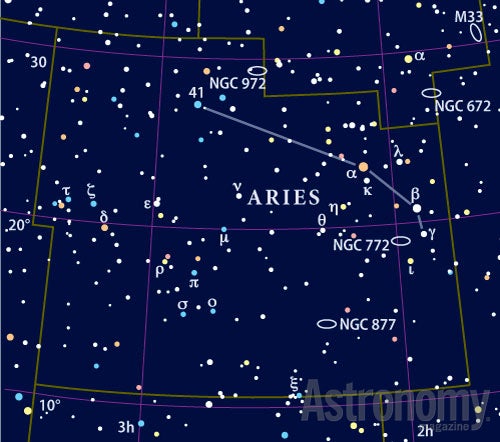
Friday, June 16
The Moon passes 4° north of Mercury at 5 P.M. EDT, though the pair is not visible in the evening sky. Instead, we’ll catch them tomorrow morning before the Sun rises.
Tonight, look north after dark to see the long constellation Draco arcing above the North Celestial Pole (marked by the star Polaris). Around 11:30 P.M. EDT, the little Dipper — with Polaris at the tip of the handle — appears to stand straight up on that handle, with Draco draped above it.
Draw a line with your eye from Polaris up through the Little Dipper to Gamma (γ) Ursae Minoris, which serves as the lower right corner of the dipper’s cup when it is right-side up with the handle extending left. Continue that line upward and you’ll eventually land on magnitude 3.3 Edasich (Iota [ι] Draconis).
Our target lies some 4° farther along that same line, southwest of Edasich’s position. We’re looking for the Spindle Galaxy, also cataloged as M102 and NGC 5866. This target is interesting both in appearance and history: Historians aren’t sure whether the 102nd entry in Messier’s not-a-comet catalog was truly this galaxy or simply a duplicate observation of a different galaxy, M101 in Ursa Major.
Regardless of its origins in the Messier list, M102 is a fascinating sight through a small scope. It should appear as a 10th-magnitude grayish streak with a brighter center. The galaxy measures about 6.6′ by 3.2′ on the sky and on dark nights, larger telescopes can uncover a thin dust lane running its length, indicating the galaxy is viewed roughly edge-on. It is this geometry that gives the galaxy its distinctive spindlelike shape when viewed from Earth.
Sunrise: 5:31 A.M.
Sunset: 8:31 P.M.
Moonrise: 4:03 A.M.
Moonset: 7:34 P.M.
Moon Phase: Waning crescent (2%)
*Times for sunrise, sunset, moonrise, and moonset are given in local time from 40° N 90° W. The Moon’s illumination is given at 12 P.M. local time from the same location.
Saturday, June 17
Mercury passes 4° north of Aldebaran, the bright red eye of Taurus the Bull, at 10 A.M. EDT. Let’s try to catch the two, together with the Moon, earlier in the morning. They’re sitting low in the east about 30 minutes before sunrise.
It’s a tricky observation for a few reasons: First, all three are very low to the horizon, just rising ahead of the Sun. Half an hour before sunrise, Mercury is just 4° high, while the Moon is 2° high and Aldebaran is hugging the horizon, barely 0.5° high. Second, the Moon is the thinnest sliver, just less than 1 percent lit, so you’ll likely need binoculars or a telescope to see the illuminated edge, and you shouldn’t be surprised if you can’t spot it. Third, Aldebaran, though a relatively bright star at magnitude 0.9, is fighting a losing battle with the brightening twilight. The star will grow fainter and ultimately wink out as it climbs higher and sunrise approaches — again, optics will help here, but make sure to stop searching several minutes before the Sun rises from your location.
Mercury will be the easiest to spot: Glowing at magnitude –0.8, it will remain visible in the sky longer than Aldebaran. If you can locate it with a telescope, note how its 6″-wide disk is not fully lit; instead, the planet currently shows off a 79-percent-illuminated gibbous phase. It’s also sinking back toward the Sun day by day, so you won’t have many more chances to see it in the morning sky.
Sunrise: 5:31 A.M.
Sunset: 8:31 P.M.
Moonrise: 4:42 A.M.
Moonset: 8:36 P.M.
Moon Phase: New

Sunday, June 18
New Moon officially occurs at 12:37 A.M. EDT; several hours later, Saturn is stationary against the background stars of Aquarius at 11 A.M. EDT. Early risers can catch the ringed planet in the southeast a few hours before sunrise, shining at magnitude 0.7. The planet lies just under 5° southwest of 4th-magnitude Hydor in Aquarius, far outshining the named stars in this dim constellation.
Through a telescope, Saturn’s disk stretches 18″ across, while its rings span more than twice that from end to end. Several moons cluster around it, including 12th-magnitude Enceladus, which crosses the planet’s southern regions, led by its shadow, for several hours this morning. The moon slips onto the disk around 2:30 A.M. EDT, with its shadow already crossing the cloud tops. The shadow disappears just before 4 A.M. EDT, while the moon takes another 45 minutes or so to cross and exit the disk. Meanwhile, brighter (magnitude 10.5) Tethys disappears into Saturn’s dark shadow around 4 A.M. EDT, having approached the planet’s northern hemisphere from the west. Much easier to spot is Saturn’s brightest moon, 8th-magnitude Titan, which lies far to the west, some 2.7′ from the planet’s center.
If you prefer to do your skywatching in the evening, tonight an excellent opportunity to try observing the zodiacal light, which will appear in the west after dusk. Wait for the sky to grow dark after sunset, then look for a dim cone of light extending upward from the horizon, running through Cancer and Leo. You can use bright Mars and Venus as guides, as the planets and the zodiacal light both lie along the ecliptic, the plane of the solar system.
Sunrise: 5:31 A.M.
Sunset: 8:31 P.M.
Moonrise: 5:30 A.M.
Moonset: 9:32 P.M.
Moon Phase: New
Monday, June 19
Let’s turn our attention to the morning sky’s other giant planet: magnitude –2.1 Jupiter, which rises shortly before 3 A.M. local daylight time. For the eastern half of the country, the planet begins its climb above the horizon with only three of its four bright Galilean moons arrayed around it: Ganymede to the east and Europa (closer in) and Callisto to the west. You may even catch sight of its Great Red Spot slowly rotating off the disk, moving west over time.
Keep an eye on the planet’s northeastern limb: Just a few minutes before 5 A.M. EDT, the fourth Galilean moon, Io, appears from behind the planet and begins pulling away to the east.
Even if you don’t get to see this event, you can still enjoy the sight of Jupiter and its moons rising higher as twilight begins to brighten the sky. Following behind it to the east are the Pleiades (M45), a young open cluster of stars in Taurus the Bull. See how many points of light you can make out within the cluster with the naked eye — many people can see six or seven, but some can see up to 9 even in moderate conditions. Once you spot them, study the pattern they make: Do they form any particular shape to your mind? Some beginning observers think this is the Little Dipper, as the stars appear to form a tiny spoon shape. However, the actual Little Dipper lies in the north and takes up a much larger chunk of the sky.
Sunrise: 5:31 A.M.
Sunset: 8:32 P.M.
Moonrise: 6:23 A.M.
Moonset: 10:19 P.M.
Moon Phase: Waxing crescent (2%)

Tuesday, June 20
Asteroid 3 Juno is in conjunction with the Sun at 4 A.M. EDT, rendering it invisible from our point of view. But there’s an even larger, more famous main-belt resident visible tonight: dwarf planet 1 Ceres.
The largest body in the main belt, Ceres is currently traveling through Virgo and is still high above the western horizon two hours after sunset. You’ll find the icy world some 2.1° east-northeast of 4th-magnitude Omicron (ο) Virginis; or, if you want a brighter jumping-off point, Ceres lies about 8.2° east-southeast of 2nd-magnitude Denebola at the tip of Leo’s tail.
Ceres itself is magnitude 8.4, meaning you can net it with binoculars or a telescope. And it’s sliding through a particularly interesting patch of sky rife with galaxies. One in particular is singularly famous: Some 5.2° northeast of Ceres is M87, a giant elliptical galaxy whose central supermassive black hole was the first to ever be imaged. M87 itself is a bright magnitude 8.6 and will look like a small white or gray fuzzball stretching about 7′ across. It lies in the heart of the massive Virgo Cluster of galaxies, and is surrounded by several smaller, fainter galaxies you may also be able to make out — check the finder chart above for some of their names and locations. Astroimagers may want to try their hand at imaging this galaxy, as the powerful jet shooting from the central black hole can be captured with relatively short exposures.
Sunrise: 5:31 A.M.
Sunset: 8:32 P.M.
Moonrise: 7:23 A.M.
Moonset: 10:58 P.M.
Moon Phase: Waxing crescent (6%)
Wednesday, June 21
The summer solstice occurs at 10:58 A.M. EDT; on this date, the Sun appears at its northernmost declination in the sky.
The now-waxing Moon passes 4° north of Venus at 9 P.M. EDT. You can check them out after sunset by looking west, where the pair is visible together at that time in Cancer. Venus lies to the lower left of the delicate crescent Moon; our satellite is now about 14 percent lit and just under 4 days old. Venus is a brilliant evening star, blazing at magnitude –4.6. Through a telescope, its disk appears 29″ across and 39 percent lit.
Some 6.5° west (to the lower right) of the Moon-Venus pair is the Beehive Cluster (M44), a young open cluster of stars in the middle of the Crab’s celestial form. And the Red Planet hangs in the sky just 4.5° east (to the upper left) of Venus. It’s located in western Leo. To Mars’ upper left is the Sickle asterism, formed by six of the Lion’s stars and anchored at its base by Regulus, Leo’s 1st-magnitude heart. Mars, at magnitude 1.7, is much fainter than Venus, though still relatively bright and easy to pick out in this region of sky. Look especially for its distinct orange-red glow, which comes from sunlight reflecting off its ruddy surface.
Sunrise: 5:32 A.M.
Sunset: 8:32 P.M.
Moonrise: 8:24 A.M.
Moonset: 11:31 P.M.
Moon Phase: Waxing crescent (12%)

Thursday, June 22
The Moon continues skipping through the sky, passing 4° north of Mars at 6 A.M. EDT. Our satellite then reaches apogee, the farthest point from Earth in its orbit, at 2:30 P.M. EDT. It will stand 251,895 miles (405,386 kilometers) away at that time.
You’ll find the Moon 6.5° east of the Red Planet in the evening sky, sitting between Mars and Leo’s Sickle. Regulus, to the Moon’s lower left, forms one point of a triangle with the other two objects. As darkness continues to fall, look to Leo’s upper left (toward north) and you’ll see the large figure of the Big Dipper in Ursa Major arcing above it. Focus on the star at the end of the Dipper’s long handle — that’s Alkaid — and move one in, to the star marking the “kink” in the handle. That’s magnitude 2.1 Mizar. But look closer — or, rather, look just slightly to the side, putting Mizar at the corner of your eye. Do you see a fainter second star nearby? This is 4th-magnitude Alcor, which huddles close to Mizar at an angular distance of just 11.8′. The close pair can be a challenge for the naked eye, but an exciting one to master; alternatively, binoculars or any telescope will easily display the pair for all to see.
Although measuring the distance to these stars has been challenging, astronomers believe there is a good chance they are physically associated, rather than simply a chance superposition on the sky.
Sunrise: 5:32 A.M.
Sunset: 8:32 P.M.
Moonrise: 9:27 A.M.
Moonset: 11:58 P.M.
Moon Phase: Waxing crescent (18%)

Friday, June 23
A few hours before sunrise this morning, Aries the Ram is rising in the east. Bright Jupiter occupies the constellation’s southwestern corner, but there’s more on offer, especially with no Moon in the sky and the heavens still dark before twilight begins.
The three brightest stars in Aries are Hamal, Sheratan, and Mesarthim — Alpha (α), Beta (β), and Gamma Arietis, respectively. They form a slightly kinked line running roughly north-south in the northwestern corner of the Ram’s domain. This morning, focus on the southernmost star, magnitude 4.5 Gamma. Roughly 1° east-southeast of this star is NGC 772, also known as the Fiddlehead Galaxy.
At 10th magnitude, you’ll want a medium or large scope for the best view. The Fiddlehead is a stunning spiral that stretches 7.3′ by 4.6′. It’s clearly distorted, with one longer, brighter arm reaching out into space. The cause of this distortion is 13th-magntude NGC 770, which lies just over 3′ southwest of NGC 772’s core. Gravitational interaction between the elliptical NGC 770 and the spiral Fiddlehead are tugging the latter’s arms out of shape.
Sunrise: 5:32 A.M.
Sunset: 8:32 P.M.
Moonrise: 10:28 A.M.
Moonset: —
Moon Phase: Waxing crescent (26%)

Sky This Week is brought to you in part by Celestron.









